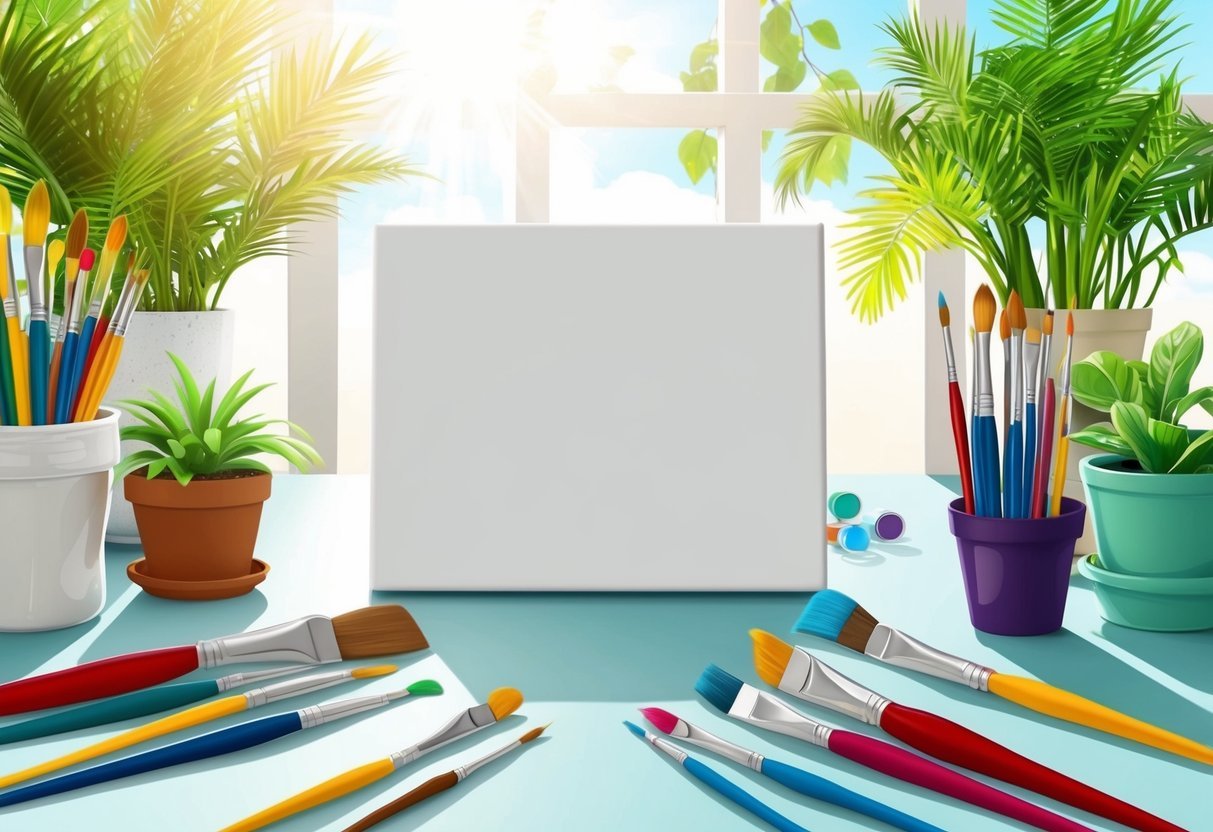Art has a special way of touching our hearts and minds. It can make us feel happy, calm, or excited. Many people find that making or looking at art helps them feel better when they’re stressed or sad.
Scientists have studied how art affects our brains. They found that art can lower anxiety and boost well-being. Creating art or doing crafts may be just as good for mental health as having a job. This is great news for anyone who likes to draw, paint, or make things with their hands.
Art therapy is a type of treatment that uses art to help people feel better. It can help with many mental health issues. Hospitals and clinics often use art to help patients heal. Even just looking at beautiful artwork can make someone’s day a little brighter.
Understanding Art and Mental Health
Art can have powerful effects on our emotions and state of mind. It offers unique ways to express feelings and work through challenges.
The Impact of Art on Mental Well-Being
Creating art lowers anxiety and helps people feel better. Painting, drawing, or sculpting allows individuals to express emotions they may struggle to put into words.
Looking at art can also be healing. Beautiful paintings or sculptures can lift one’s mood and provide a sense of calm.
Art activities give people a chance to focus on something positive. This can be a welcome break from stress or negative thoughts.
Some therapists use art in treatment for conditions like anxiety, depression, and PTSD. Creating art helps patients process difficult experiences and emotions.
Art Therapy as a Professional Discipline
Art therapy is a mental health profession that uses art-making to improve well-being. Trained art therapists guide clients through creative activities as part of treatment.
In art therapy sessions, the process of making art is often more important than the final product. Therapists may ask clients to:
• Draw their feelings
• Paint a safe place
• Sculpt an emotion
Art therapists help clients explore the meanings behind their artwork. This can lead to new insights and healing.
Art therapy can help with many conditions, including:
- Depression
- Anxiety
- Trauma
- Eating disorders
The field combines knowledge of psychology, human development, and visual art.
Exploring Various Art Forms
Art can help people feel better in many ways. Different types of art like painting, music, dance, and writing each have special ways of improving mental health.
Visual Art and its Therapeutic Effects
Visual art like painting and drawing can calm the mind. It lets people express feelings they can’t put into words.
Making art reduces stress and anxiety. It can boost self-esteem and help process difficult emotions.
Coloring books for adults have become popular for relaxation. Even simple doodling can improve mood and focus.
Art museums offer a peaceful place to view inspiring works. This can lift spirits and provide new perspectives on life.
The Healing Rhythms of Music
Music touches emotions in powerful ways. Listening to favorite songs can quickly improve mood.
Playing an instrument or singing releases feel-good brain chemicals. It reduces stress and anxiety.
Music therapy helps treat depression, trauma, and other mental health issues. Drumming circles build community and relieve tension.
Calming classical music can lower blood pressure and heart rate. Upbeat tunes boost energy and motivation for exercise or work.
Movement and Wellness in Dance
Dance combines music, exercise, and self-expression. It’s great for physical and mental health.
Moving to music releases tension in the body and mind. It improves flexibility, balance, and coordination.
Group dance classes build social connections. Partner dances like salsa foster trust and intimacy.
Creative movement lets people express emotions through their bodies. This can relieve stress and boost mood.
Even simple swaying or tapping toes to music counts as dance. Small movements still provide mental health benefits.
Expressive Writing and Emotional Relief
Writing in a journal helps process difficult feelings. It can reduce symptoms of anxiety and depression.
Poetry allows creative expression of emotions. Sharing poems can help people feel understood.
Writing stories lets people explore different perspectives. This builds empathy and self-awareness.
Letter writing, even unsent, helps release pent-up thoughts. It can improve relationships and communication.
Daily gratitude writing boosts overall well-being. Focusing on positives improves outlook over time.
The Role of Creativity in Mental Health
Art and creative activities can boost mental well-being. They offer ways to express feelings and deal with stress. Creative pursuits also help people explore their inner world and connect with others.
Enhancing Self-Expression Through Art-Making
Art-making allows people to share thoughts and feelings without words. Painting, drawing, or sculpting can help process complex emotions. These activities promote mental health by reducing stress and anxiety.
Creating art builds self-esteem and confidence. It gives a sense of achievement and pride in one’s work. Art can also be a safe way to explore difficult experiences or traumas.
Group art projects foster social connections. They help people feel less alone and more understood. Sharing artwork can lead to meaningful conversations and new friendships.
Creative Arts Therapies in Clinical Settings
Creative arts therapies use art, music, dance, or drama to improve mental health. Trained therapists guide patients through creative activities. These therapies can help with various mental health issues.
Art therapy helps patients express feelings they struggle to put into words. It can reduce symptoms of depression and anxiety. Music therapy can improve mood and reduce pain in some patients.
Dance and movement therapy helps people become more aware of their bodies. It can boost self-esteem and reduce stress. Drama therapy allows patients to act out difficult scenarios in a safe space.
These therapies work well alongside traditional treatments. They offer new ways for patients to heal and grow.
Artistic Engagement with Specific Conditions
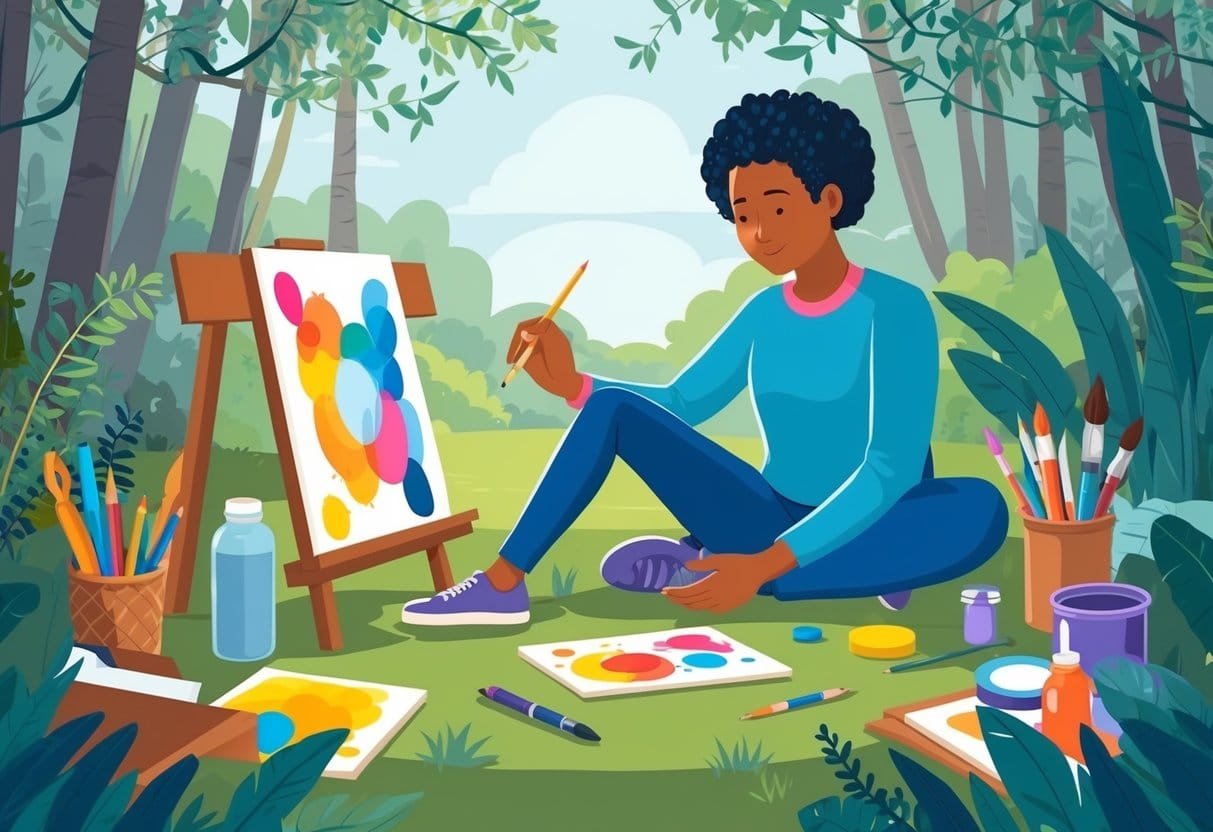
Art can help people cope with many mental health issues. It allows expression of difficult emotions and experiences. Different art forms may benefit various conditions in unique ways.
Art Therapy for Anxiety and Depression
Art therapy can help people with anxiety and depression. Painting, drawing, or sculpting may reduce stress. These activities can take a person’s mind off worries.
For anxiety, calm scenes or abstract shapes might soothe nerves. Bright colors could lift moods for those with depression. The act of creating art itself can boost happiness.
Group art classes also give a chance to connect with others. This fights loneliness, which often comes with depression. Art lets people express feelings they find hard to put into words.
Emotional Healing for Trauma and PTSD
Art helps process difficult memories for those with trauma or PTSD. It offers a safe way to explore painful experiences. Creating art can aid in healing from these conditions.
Collage-making lets people piece together fragmented memories. Pottery gives a sense of control, as the artist shapes the clay. Painting allows expression of emotions tied to traumatic events.
Art therapy also teaches coping skills. Deep breathing while painting can calm the body. Focusing on art projects may ease flashbacks or anxiety attacks.
Coping with Chronic Conditions Through Art
People with long-term health issues find comfort in art. It helps manage pain, fatigue, and stress from illnesses like cancer. Art offers a positive focus away from symptoms.
For those with limited mobility, adaptive tools make art possible. Even small projects boost mood and self-esteem. Art can be a form of meditation, easing physical discomfort.
Making art improves well-being for many chronic conditions. It gives a sense of purpose and achievement. Sharing artwork with others can also build supportive communities.
Psychological Theories in Art Therapy
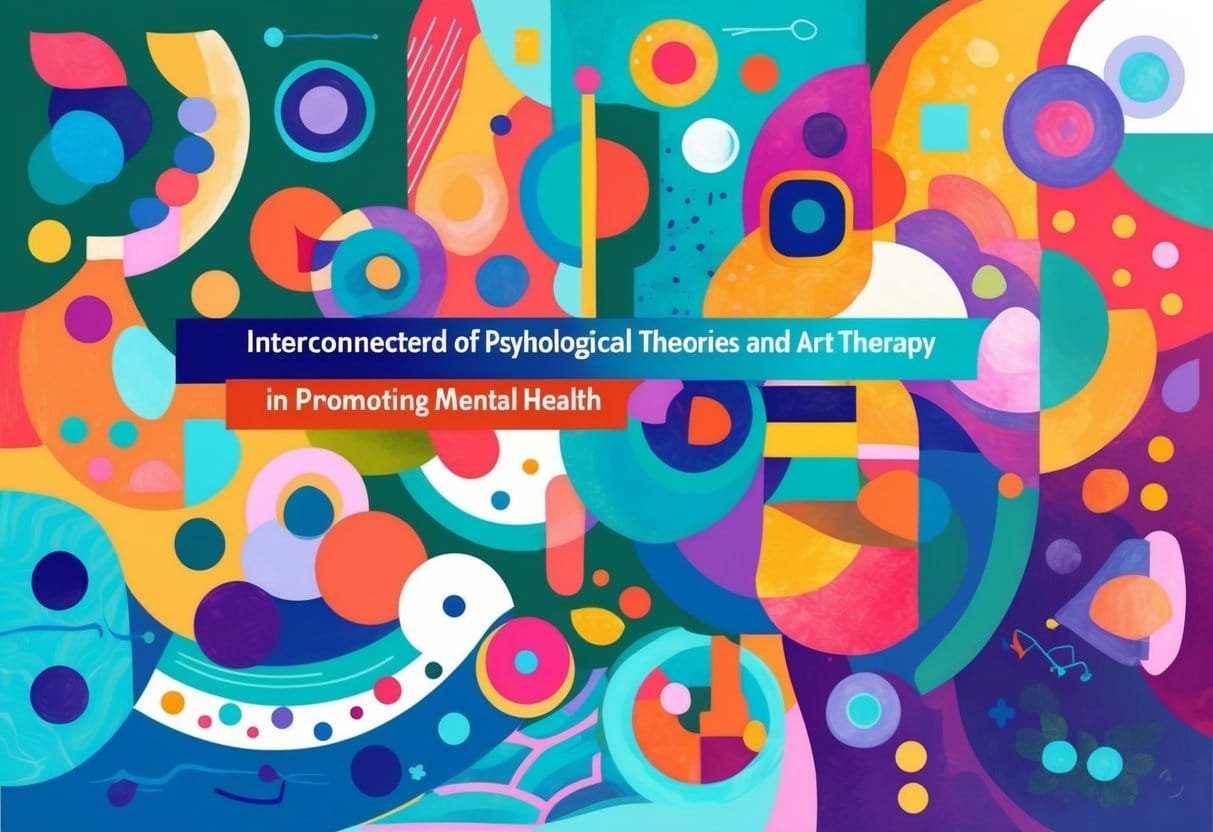
Art therapy taps into deep psychological processes. It helps people express emotions and enter flow states through creative activities. These mental shifts can improve mood and ease psychological distress.
The Science of Emotions and Art
Art activities affect brain chemistry in ways that boost mood. Making art lowers stress hormones like cortisol. It also raises feel-good chemicals like serotonin and dopamine.
This leads to more positive emotions. People often feel calmer and happier after art sessions. The act of creating art can help process difficult feelings too. Putting emotions onto paper or canvas makes them easier to understand and work through.
For those with mental illness, art offers a way to express what’s hard to say in words. It gives a voice to inner struggles. This emotional release through art can ease symptoms of conditions like depression and anxiety.
Flow State and Its Connection to Creativity
Flow is a mental state where a person gets fully absorbed in an activity. It often happens during creative tasks like painting or sculpting. In flow, worries fade away and time seems to fly by.
Getting into flow through art has many benefits:
- Reduces anxiety
- Boosts mood
- Increases focus
- Improves self-esteem
Regular flow experiences can help manage long-term psychological distress. They give the brain a break from negative thought patterns. This mental reset can lead to better overall well-being.
Art therapists use flow to help clients find moments of peace. They guide people to lose themselves in the creative process. This can be especially helpful for those dealing with racing thoughts or constant worry.
Art in Developmental and Educational Contexts
Art plays a key role in children’s growth and learning. It helps kids express themselves and develop important skills. Schools are using art in new ways to support students’ well-being and education.
Art Therapy in Schools and Support for Children
Art therapy is becoming more common in schools. It gives kids a way to work through tough feelings and experiences. Trained therapists use drawing, painting, and other art forms to help students.
Art activities in class can boost learning too. They help children focus and be creative. Teachers might use art projects to teach subjects like history or science.
For some kids, art is a way to shine. It builds their confidence and helps them make friends. Group art projects teach teamwork and communication.
Schools are also using art to support mental health. Painting or sculpting can be calming for stressed students. It gives them a break from academic pressures.
Art programs help children develop in many ways. They improve fine motor skills and problem-solving abilities. Kids learn to express ideas and emotions through their creations.
Social and Cultural Aspects of Art in Healing
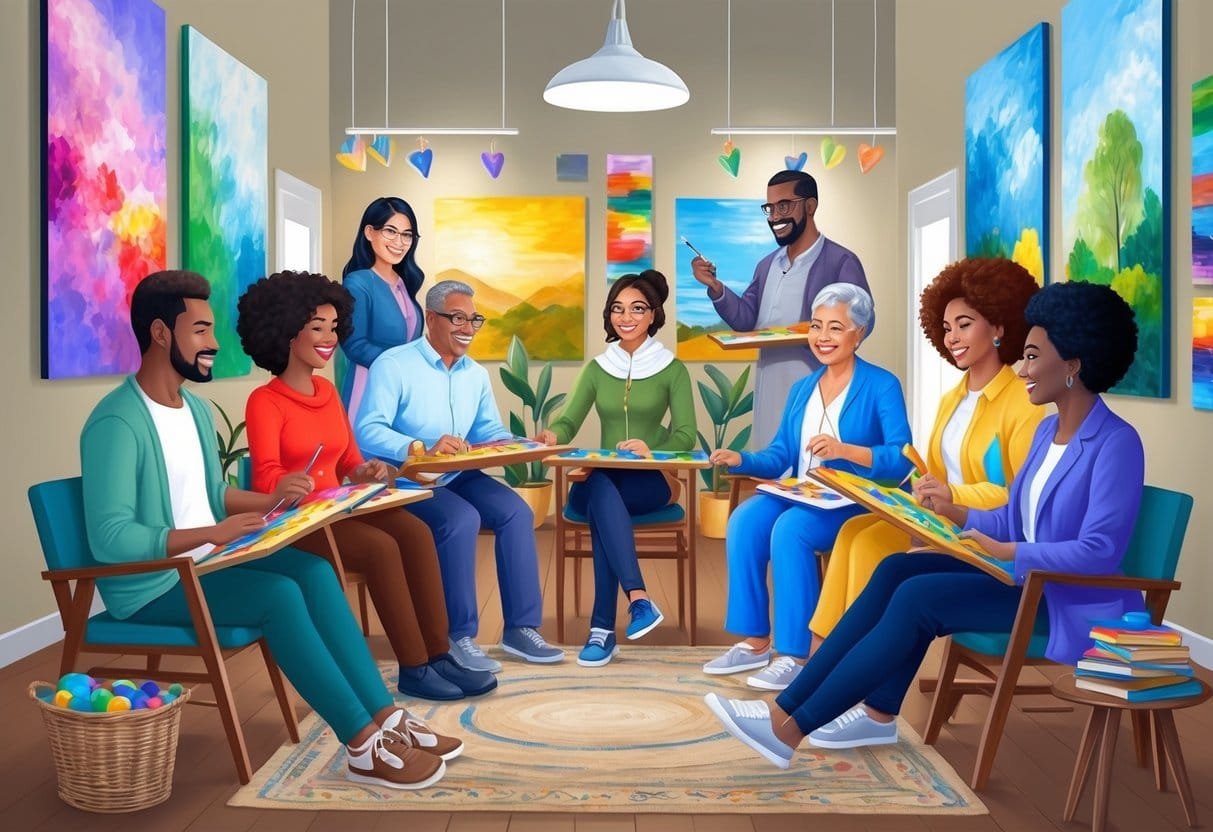
Art has the power to bring people together and change how we think about mental health. It can help break down barriers and create new connections in our communities.
Community Art Projects and Mental Health
Community art projects can have a big impact on mental health. These projects bring people together to create something beautiful. They help build friendships and support networks.
Artists often lead these projects. They work with groups to express shared ideas and feelings through art. This can be very healing for everyone involved.
Community art can take many forms. It might be a mural, a sculpture, or even a performance. The key is that it’s made by and for the community.
These projects can help people feel less alone. They give a voice to those who might not otherwise be heard. This can be especially helpful for those dealing with mental health challenges.
The Stigma of Mental Illness and Art’s Role
Art can play a big role in fighting the stigma around mental illness. It gives people a way to share their lived experiences in a safe, creative way.
Art therapy is one way to do this. It helps people express feelings that might be hard to put into words. This can lead to better understanding and empathy from others.
Artists with mental health conditions often use their work to educate others. Their art can show what it’s really like to live with mental illness. This helps break down stereotypes and misconceptions.
Public art displays about mental health can reach a wide audience. They start conversations and challenge people’s views. This can lead to more open and supportive communities.
Techniques and Modalities in Art Therapy
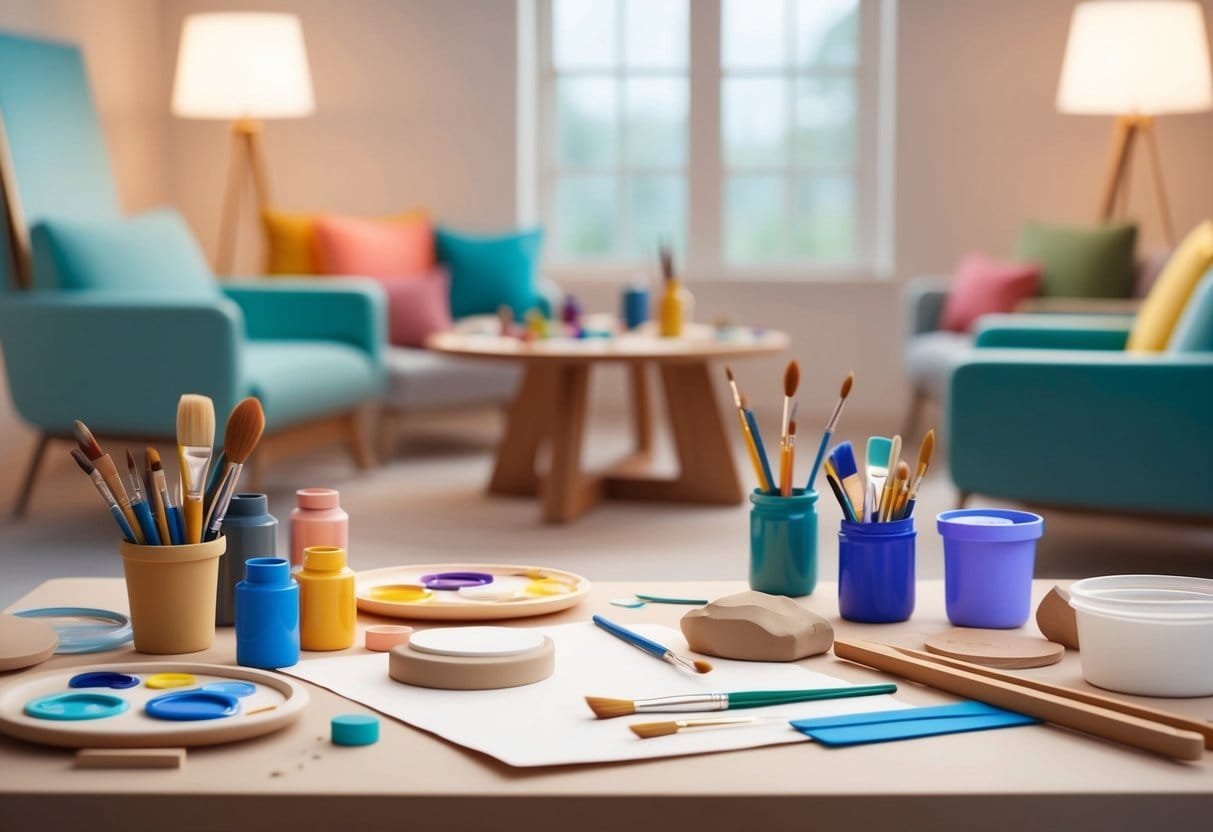
Art therapy uses many creative methods to help people express themselves. These techniques can boost mental health in unique ways.
Innovative Approaches to Using Art Mediums
Art therapy goes beyond traditional painting and drawing. It includes collage, photography, and sculpture. Therapists might ask clients to make a collage about their feelings. This can help reveal hidden thoughts.
Doodling and coloring are simple but powerful tools. They can calm the mind and reduce stress. Working with clay lets people shape their emotions in 3D. This can be very freeing.
Oil painting offers a chance to blend colors and ideas. The slow drying time allows for reflection during the process. Photography helps capture moments and perspectives. It can show how someone sees the world.
Understanding and Developing Artistic Talent and Technique
Art therapy isn’t about being “good” at art. It’s about expression. Still, learning new skills can boost confidence. Therapists might teach basic techniques to help clients feel more comfortable.
They might show how to mix colors or use shading. This can help people express themselves better. As skills grow, so does the ability to communicate through art.
Some people discover hidden talents in therapy. This can be a big boost to self-esteem. Therapists encourage exploration of different styles and mediums. This helps find what works best for each person.
Art therapy techniques can include:
- Finger painting
- Sculpting with clay
- Drawing with pastels
- Creating digital art
Each method offers unique benefits. The goal is to find what feels right for the individual.
Addressing Global Crises Through Art Therapy

Art therapy has emerged as a powerful tool for coping with worldwide challenges. It helps people process difficult emotions and find meaning during tough times.
Art Therapy during the Coronavirus Pandemic
The coronavirus pandemic brought fear, isolation, and grief to many. Art therapy offered a way to express these complex feelings. People used painting, drawing, and other creative activities to reduce stress and anxiety.
Virtual art therapy sessions became popular during lockdowns. These online meetings allowed people to connect and heal together from a distance.
Art therapists helped frontline workers process trauma through creative projects. Healthcare staff made art to cope with the intense emotions of treating COVID patients.
Many found comfort in making coronavirus-themed art. They painted rainbows, drew portraits of loved ones, and created memorial pieces. This art helped them grieve losses and find hope.
Community art projects brought people together safely. Neighbors made chalk drawings or window displays. These creative acts fostered a sense of unity during a time of separation.
Advancing Mental Health Care and Policy
Mental health care is changing. New ideas are making treatment better for more people. Art therapy is becoming part of this progress.
Integrating Art Therapy in Hospitals and Health Insurance
Many hospitals now offer art therapy. Patients can paint, draw, or sculpt as part of their care. This helps them express feelings and reduce stress.
Some health insurance plans cover art therapy sessions. This makes it easier for people to try this treatment. More coverage means more access to care.
Art rooms are popping up in mental health units. These spaces give patients a creative outlet. Nurses and doctors see how art helps healing.
Professional Training and Accreditation for Art Therapists
Art therapy is now taught as a special field in schools. Students learn about both art and mental health. This mix of skills helps them work with different patients.
Art therapists need special training. They study for years to get the right skills. After school, they take tests to become certified.
Hospitals look for therapists with the right credentials. This ensures patients get quality care. Trained art therapists know how to use art safely in treatment.
Ongoing education keeps therapists up-to-date. They learn new ways to help patients through art. This makes mental health care better for everyone.

